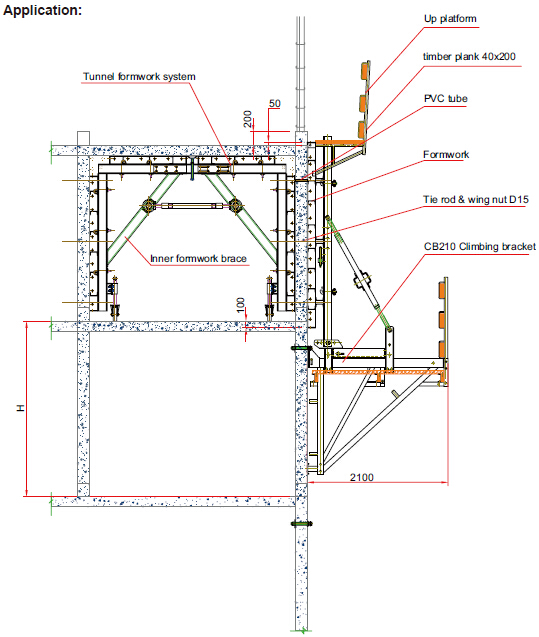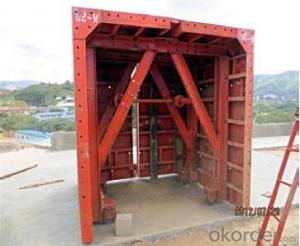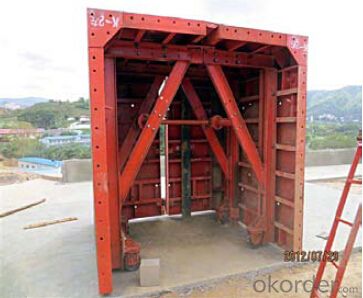Steel-Tunnel for formwork and scaffolding system
- Loading Port:
- Tianjin
- Payment Terms:
- TT OR LC
- Min Order Qty:
- 50 m²
- Supply Capability:
- 1000 m²/month
OKorder Service Pledge
Quality Product, Order Online Tracking, Timely Delivery
OKorder Financial Service
Credit Rating, Credit Services, Credit Purchasing
You Might Also Like
Building Tunnel Formwork:
A compositional steel formwork system mainly used in the building which has regular structure
without beams, the excellent formwork system can make the integral pouring for the wall & slab
easily achieved.
Characteristics:
◆ High stiffness, make perfect shape for concrete.
◆ Easy operation, save labor and force.
◆ Fast forming, repeatedly turnover.

- Q: What are the different types of formwork release agents used with steel formwork?
- Steel formwork can be used with various types of formwork release agents. These agents are applied to the formwork surface before pouring concrete to prevent sticking and ease removal after curing. A commonly used formwork release agent for steel formwork is petroleum-based. It consists of petroleum oils and additives, creating a thin lubricating film on the formwork surface. This film reduces friction between the formwork and concrete, facilitating damage-free formwork removal. Another option for steel formwork is water-based release agent. It contains water, surfactants, and additives, forming a barrier between the formwork and concrete to prevent adhesion. Water-based agents are preferred when environmental concerns or safety considerations make petroleum-based agents less suitable. Apart from petroleum-based and water-based agents, there are specialty formwork release agents available for steel formwork. These agents may be tailored for specific applications or performance requirements. For instance, high-performance release agents are designed to offer superior release in challenging conditions like high temperatures or humidity. Additionally, there are agents specifically formulated for use with certain concrete types, such as self-consolidating or high-strength concrete. Ultimately, selecting the appropriate formwork release agent for steel formwork depends on project requirements, environmental factors, and personal preferences. Careful selection and correct application of the release agent are crucial for successful formwork removal and achieving the desired concrete finish.
- Q: What are the common quality control measures for steel formwork?
- Common quality control measures for steel formwork include: 1. Visual Inspection: This involves a thorough examination of the steel formwork to check for any visible defects or damage. Any signs of cracks, dents, or deformations should be identified and addressed. 2. Dimensional Accuracy: The dimensions of the steel formwork, such as the length, width, and height, should be measured and compared to the specified requirements. Any deviations from the required dimensions should be corrected. 3. Material Testing: Steel formwork should undergo material testing to ensure that it meets the required standards and specifications. This may involve testing the tensile strength, yield strength, hardness, and chemical composition of the steel. 4. Welding Inspection: If the steel formwork is welded, the quality of the welds should be inspected. This includes checking for proper penetration, fusion, and the absence of any defects like cracks or porosity. Non-destructive testing methods like ultrasonic or radiographic testing can be employed to ensure the integrity of the welds. 5. Surface Coating Inspection: The surface coating of the steel formwork, such as paint or galvanized coating, should be inspected for its thickness, adhesion, and uniformity. This ensures protection against corrosion and enhances the durability of the formwork. 6. Load Testing: Steel formwork should be subjected to load testing to evaluate its structural integrity and load-bearing capacity. This involves applying a known load to the formwork and monitoring its response to ensure it can safely support the required loads during construction. 7. Documentation and Record Keeping: Quality control measures should be documented and records should be maintained for future reference. This includes recording the inspection results, material test reports, and any corrective actions taken. These quality control measures help to ensure that steel formwork meets the required standards, specifications, and safety regulations, ultimately ensuring the structural integrity and performance of the formwork during construction.
- Q: How does steel formwork handle different concrete reinforcement spacing?
- Steel formwork is a versatile and robust solution that can easily handle different concrete reinforcement spacing. The formwork itself consists of steel panels or frames that are designed to be adjustable and flexible, allowing for customization according to the specific reinforcement spacing required for a particular concrete structure. Steel formwork panels have various features that make them suitable for accommodating different reinforcement spacing. These panels are typically available in different sizes and shapes, allowing for easy adjustment to fit the desired spacing. Additionally, the panels are usually equipped with adjustable clamps or connectors that enable them to be securely joined together, providing stability and support for the concrete. When it comes to concrete reinforcement spacing, steel formwork can be adapted to meet the specific requirements. The steel panels can be easily positioned and aligned to create the desired spacing for the reinforcement bars. This can be achieved by adjusting the panels horizontally or vertically to accommodate the required distance between the bars. Furthermore, steel formwork provides the necessary strength and durability to withstand the pressure exerted by the concrete during the pouring and curing process. This ensures that the formwork remains intact and stable, even when dealing with different reinforcement spacing. In conclusion, steel formwork is well-equipped to handle different concrete reinforcement spacing. Its adjustable and flexible design allows for customization to fit the specific requirements of each project. The strength and durability of steel formwork ensure that it can effectively support the concrete and maintain its stability throughout the construction process.
- Q: How does steel formwork handle concrete temperature differentials?
- Steel formwork is a popular choice for concrete construction due to its durability and strength. When it comes to handling concrete temperature differentials, steel formwork offers several advantages. Firstly, steel has a high coefficient of thermal conductivity, meaning it can quickly absorb and distribute heat. This property allows steel formwork to efficiently dissipate the heat generated during the hydration process of concrete. As a result, steel formwork helps to minimize the risk of thermal cracking caused by temperature differentials. Furthermore, steel formwork is known for its dimensional stability. Unlike other materials like wood, steel does not expand or contract significantly with temperature changes. This stability ensures that the formwork maintains its shape and integrity, even when exposed to varying concrete temperatures. It helps to prevent any distortions, warping, or bulging that could affect the quality and appearance of the concrete structure. Additionally, steel formwork is resistant to fire and high temperatures, making it suitable for handling concrete that undergoes rapid temperature changes, such as in hot weather conditions or during the curing process. Its ability to withstand extreme temperatures without deforming or losing its structural integrity ensures that the formwork remains intact and provides the necessary support and containment for the concrete. In summary, steel formwork effectively handles concrete temperature differentials by efficiently dissipating heat, maintaining dimensional stability, and withstanding high temperatures. These properties contribute to the overall quality and durability of the concrete structure, while minimizing the risk of thermal cracking and other issues caused by temperature variations.
- Q: Can steel formwork be used for both monolithic and composite structures?
- Yes, steel formwork can be used for both monolithic and composite structures. Steel formwork provides the necessary strength and durability required for these types of structures, making it a versatile option for construction projects.
- Q: What are the different types of joints used in steel formwork?
- Steel formwork for construction projects commonly utilizes various types of joints to ensure stability and proper alignment of the system. 1. The most basic joint is the butt joint, which involves placing two formwork panels together with their edges abutting. Additional reinforcement, such as steel plates or angles, is often used to enhance strength and stability. 2. Corner joints, as the name suggests, connect formwork panels at corners. These joints are usually reinforced with steel angles or brackets to ensure proper alignment and support. 3. T-joints are used when formwork panels intersect at a perpendicular angle. This joint involves connecting three panels together, with one positioned perpendicular to the other two. 4. L-joints are similar to T-joints but are used when panels intersect at a 90-degree angle. This joint involves connecting two panels together, with one positioned perpendicular to the other. 5. Lap joints are used to connect long formwork panels, creating a continuous surface. This joint involves overlapping the edges of two panels and securing them with bolts or clamps. 6. Hinged joints are employed when adjustable or movable formwork panels are required. This joint allows for flexibility in placement and can be locked in different positions to accommodate various shapes and sizes. It is essential to consider the specific requirements of the construction project, including the desired formwork system and structural design, when selecting the appropriate joint. This selection plays a crucial role in ensuring the overall stability and strength of the formwork system.
- Q: What are the typical corrosion protection measures for steel formwork systems?
- There are several typical corrosion protection measures for steel formwork systems that can help extend their lifespan and maintain their structural integrity. One common method is the application of protective coatings. This can include the use of epoxy coatings, which provide a barrier against moisture and corrosive elements. These coatings are typically applied to the entire surface of the steel formwork system, including any joints or connection points. The coating acts as a protective layer, preventing direct contact between the steel and the surrounding environment. Another measure is the use of galvanizing. Galvanizing involves coating the steel formwork system with a layer of zinc. This process creates a protective barrier that helps prevent corrosion. Galvanizing is particularly effective in environments with high levels of moisture or exposure to saltwater, such as coastal areas. Regular maintenance is also essential for corrosion protection. This includes inspecting the formwork system for any signs of damage or deterioration, such as rust or pitting. Any areas of concern should be addressed promptly, either through repair or replacement. Additionally, regular cleaning and removal of any debris or contaminants can help prevent corrosion from occurring. Proper storage and handling of the steel formwork system is another important measure. The formwork should be stored in a dry, well-ventilated area to minimize exposure to moisture. It should also be handled correctly to avoid any unnecessary damage or scratches, which can compromise the protective coatings. Lastly, the use of sacrificial anodes can be employed as a corrosion protection measure. Sacrificial anodes are made from a metal that is more reactive than the steel formwork system, such as zinc or magnesium. When attached to the formwork, the sacrificial anode corrodes instead of the steel, effectively sacrificing itself to protect the system. Overall, a combination of protective coatings, galvanizing, regular maintenance, proper storage, and sacrificial anodes can provide effective corrosion protection for steel formwork systems, ensuring their longevity and durability.
- Q: What are the main components of steel formwork?
- The main components of steel formwork typically include panels, stiffeners, connectors, and accessories such as form ties, wedges, and pins.
- Q: What are the different components of steel formwork?
- Steel formwork is a type of temporary structure that is used in construction projects to provide support and shape to concrete during the curing process. It consists of several components that work together to create a rigid and durable formwork system. The main components of steel formwork include: 1. Panels: These are the primary components of the formwork system and are usually made of steel or steel-reinforced plywood. They are available in different sizes and shapes and can be easily interconnected to create the desired formwork configuration. 2. Soldiers: These are vertical members that provide support to the formwork panels. They are typically made of steel and are adjustable in height, allowing for flexibility in formwork design. Soldiers are connected to the panels using connecting clamps or pins. 3. Waler Beams: These are horizontal members that help distribute the load evenly across the formwork system. Waler beams are connected to the soldiers using clamps or brackets and are usually made of steel or aluminum. 4. Tie Rods: These are used to hold the formwork panels and soldiers together. They are threaded rods that pass through the panels and are secured with nuts and washers on each side. Tie rods help in maintaining the required spacing between the panels and provide additional strength to the formwork system. 5. Formwork Accessories: These include various components such as clamps, brackets, wedges, and pins that are used to connect and secure the formwork components. They help in maintaining the stability and alignment of the formwork system during concrete pouring and curing. 6. Formwork Joints: These are specially designed connectors that allow for easy assembly and disassembly of the formwork system. They ensure proper alignment and tightness of the formwork components, preventing leakage of concrete and maintaining the desired shape. 7. Formwork Supports: These are used to provide additional support to the formwork system, especially for larger and complex structures. Formwork supports can be in the form of props, scaffolding, or specialized shoring systems, depending on the specific requirements of the project. Overall, these components work together to create a strong and stable formwork system that can withstand the pressure and weight of the concrete during the construction process. Steel formwork is preferred for its durability, reusability, and ease of assembly and disassembly, making it a popular choice in modern construction projects.
- Q: How does steel formwork affect the overall durability of the structure?
- Steel formwork can have a significant impact on the overall durability of a structure. Steel is known for its strength and durability, making it an ideal material for formwork. One of the key ways in which steel formwork affects the durability of a structure is through its ability to withstand the forces and pressures exerted during the construction process. Steel formwork provides excellent support and stability to the concrete during pouring and curing, ensuring that it maintains its shape and strength. This helps to prevent any deformation or cracking that could compromise the overall durability of the structure. Additionally, steel formwork is highly resistant to wear and tear, which is crucial for projects that involve multiple concrete pours. Unlike other types of formwork such as timber, steel formwork does not warp, shrink, or expand due to moisture or temperature changes. This allows for multiple uses and reuses, reducing the need for frequent replacements and ultimately increasing the lifespan of the structure. Furthermore, steel formwork offers superior protection against environmental factors such as corrosion and fire. Steel is inherently resistant to rust and decay, which can significantly extend the lifespan of the formwork and consequently the structure itself. Moreover, steel formwork provides higher fire resistance compared to other materials, reducing the risk of structural damage and enhancing the overall durability of the building. In summary, steel formwork positively affects the overall durability of a structure by providing excellent support, stability, and protection against various forces and environmental factors. Its strength, resistance to wear and tear, and superior properties make it a reliable choice for construction projects, ensuring the longevity and durability of the structure.
Send your message to us
Steel-Tunnel for formwork and scaffolding system
- Loading Port:
- Tianjin
- Payment Terms:
- TT OR LC
- Min Order Qty:
- 50 m²
- Supply Capability:
- 1000 m²/month
OKorder Service Pledge
Quality Product, Order Online Tracking, Timely Delivery
OKorder Financial Service
Credit Rating, Credit Services, Credit Purchasing
Similar products
Hot products
Hot Searches
Related keywords

















